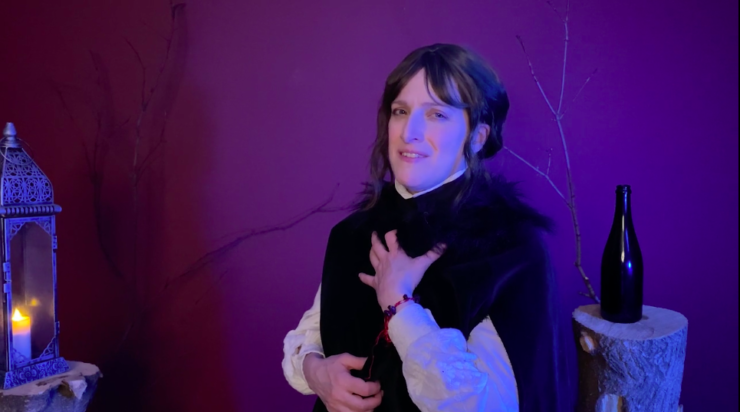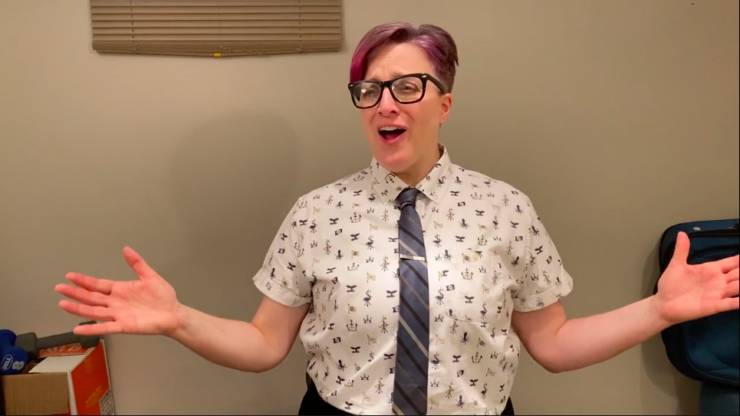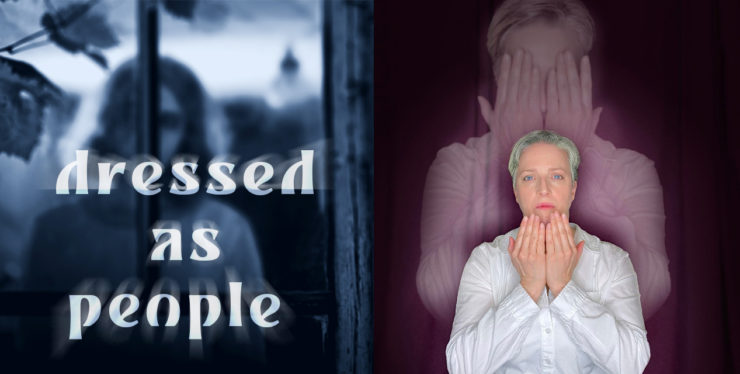Theater has undergone a radical transformation in the past year-plus of the pandemic, challenging writers, actors, and producers to embrace the limitations and possibilities of the digital space. What these artists have been forced to trade in the intimacy of live performance they have been able to discover in opportunities for greater accessibility—and, in the case of the Ottawa Fringe Festival’s Dressed as People—a Triptych of Uncanny Abduction, the opportunity for unexpected collaboration.
Parry Riposte Productions has brought together actor and dramaturg Margo MacDonald, director Mary Ellis, musician SIESKI, and speculative fiction writers Kelly Robson, A.M. Dellamonica, and Amal El-Mohtar for this fascinating and affecting dramatic experiment. Their joint effort best resembles a theatrical micro-anthology: three monologues each running about 20 minutes, the settings ranging from an enchanted forest in 1800s England to a haunted school in 1950s Ireland to the intensely recognizable close quarters of someone recording from their apartment in 2021. Fans of each writer’s work will glimpse beloved mythical creatures and poignant themes, translated into a new medium yet still familiar.
It’s shocking to learn that Dellamonica, El-Mohtar, and Robson did not consult one another while writing, that each took the theme of abduction and the phrase “dressed as people” and turned out these pieces that fit together remarkably. Though the phrase is used most memorably in Robson’s opening monologue, it establishes an ongoing sense, over the 75-minute presentation, of shifting states and of the varied meanings of being a changeling, from the traditional faerie archetype to creatures that can exist in multiple physical states or more existential spheres.
Yet the heart of each of these monologues is not the ones who leave, but the ones who are left. MacDonald inhabits each character so completely that, put side-by-side, it would truly be difficult to discern the same performer beneath. The monologues are stitched together in such a way as to mimic a back-to-back night of theater, yet the benefit of the digital space is that it erases the delays that would come from swapping out wigs or striking one sparse-but-deliberate set to replace it with another. In that way, there is no momentum lost between monologues, which strengthens their connective tissues.
It’s difficult to examine each story wholly divorced from the others, as to do so would sever the ties between them. Instead, it’s a pleasure to witness great minds thinking alike, while still demonstrating how distinctive their individual filters on the world, and on speculative fiction, are.
“Skinless” by Kelly Robson

Pun somewhat intended, “Skinless” provides the narrative backbone for this evening of theater. As nun-turned-professor Dr. Sheedy, MacDonald plays the wry amusement of a teacher observing her students’ surprise that in her casual garb she’s “dressed as people,” setting the tone for her Introduction to Canadian Literature course as well as the seemingly unrelated story she has to share as the preamble to the class. After all, she points out, while many of her students have been more likely to encounter American and British stories over CanLit, they must not discount “how powerful it is to have your own experience and your own culture reflected back at you.”
Yet before diving into CanLit in 1989, first Dr. Sheedy transports her captive audience back to her past life in 1950s Ireland, running a convent for children and especially young girls who had gotten themselves into trouble. What follows is a recounting of how the quotidian horrors of the past shift seamlessly into more primitive horrors, as Sheedy would chase after, and grow to care for, a particular pregnant girl constantly trying to escape the school for the seemingly eerier barren woods nearby.
As Sheedy explains, stories, like maps, are only at their most effective on a 1:1 scale, so that the listener might step into a space as full and detailed and immediate as it was for the teller. One would argue that this is even more vital for a ghost story, when the only proof comes secondhand from the person who beheld the supernatural. MacDonald-as-Sheedy ably immerses the audience for the most part, though the added layer of recollection can sometimes render the horror aspect a tad too subtle. SIESKI’s music aids in these moments, a haunting chant that fills in the sense of the mysterious woods better than a set could. Robson employs skillful misdirection throughout this monologue, in what initially seems like a teacher’s self-indulgence in revisiting the past, only to end on a powerful last note that fulfills the title and leaves the viewer still shivering as if they were actually there.
The Ottawa Fringe has included a content warning for “Skinless,” recognizing that its story, though set in 1950s Ireland, may nonetheless be disturbing to Canadian audiences based on recent events. They have offered a transcript option for viewers who may not wish to engage with the performed monologue.
“The Shape of My Teeth” by Amal El-Mohtar

El-Mohtar’s monologue was my personal favorite of the three, despite the fact that it had the most to overcome in terms of a convincing setting (Mortimer Forest, England, 1827) and a character who required MacDonald to constantly swing between between girlish cheer and womanly resignation. “Teeth” possesses the most immediacy, though that is paired with a formality that can distance the viewer rather than invite, at least for the first few minutes. Like in “Skinless,” a woman (here, with hair the color of wet bark) has followed a girl into these woods. But rather than be a passive observer, she is here to negotiate. Armed with a bracelet of berries and wielding a wine bottle as offering, she seeks an audience with the fair folk, who snatched her best friend seven years ago.
But as the monologue unspools, it becomes clear that this is a more complicated abduction than it had initially seemed. El-Mohtar’s description of female friendship nurtured with long hours spent acting out fairy tales and forbidden romance novels in the woods lends the piece a timeless air while still grounding it in a yearning that physically aches—who hasn’t wanted to run away with their best friend? And when stories aren’t enough to transport two seeming soulmates, or when the storytellers clash instead of collaborate, can you blame them for turning to magical or even monstrous means of escape?
Fans of This is How You Lose the Time War will appreciate the thematic similarities of communicating through literary allusions and hidden messages, even if it’s a one-sided search for hints of another person’s presence or lack thereof—whichever they need more for closure. Again, SIESKI comes in at key points with a similar chanting that evokes less nightmarish ghosts and more the everyday glimpses of another world just through the trees.
“Repositioning” by A.M. Dellamonica

Dellamonica’s monologue, set in modern-day, post-pandemic Vancouver, has the most naturalistic framing of the three: MacDonald demonstrates her greatest transformation into Erica Prince, a queer stand-up comedian who specializes in the lesbian cruise circuit, recording a demo reel for her next gig. But really she’s using the constraints of a video camera to process what happened to her on her latest voyage: She met a girl. But not just any girl—the kind of exquisite creature one could only encounter out on the ocean, late at night, when the water is pitch-dark except for a strange light pulsing beneath the surface…
It’s tempting to think that “Repositioning” could take place in Dellamonica’s Stormwrack universe. Erica’s story—which she herself is still trying to figure out in the telling—has the heady feel of a portal fantasy, and her seawater-drenched paramour will be familiar to Dellamonica’s readers. Regardless, this works wonderfully as a standalone narrative because of its equal attention between underwater mysteries, sure, but also the traumas on-land that would make someone amenable to being abducted.
Like with “Skinless,” the monologue lags in parts from having a storyteller who must constantly reorient herself; an added dimension in which Erica keeps breaking her own patter to reassure the eventual audience that her bits kill works better in some moments than in others. But like in “Teeth,” her pain is so close to the surface that it maintains the urgency, especially as she delves into what happens after her amphibious meet-cute. SIESKI’s music works best in this monologue, shifting skillfully between what resembles a siren song and what sounds like an ordinary woman trying to reconcile the extraordinary.
The beauty of this format is that you could space each monologue apart and experience them on different days (for as long as the festival runs), but for the best viewing experience it is recommended that you take in all three at once. Hearing the repetition of stories, of women bonded by play and trauma and escape, builds the sensation of a spell being cast, amplified by SIESKI’s ethereal (and never over-used) voice. Parry Riposte Productions’ technical director Titus Androgynous and graphic designer K bring it all together through tone-setting credits and the visuals above.
Really, all of this work creates the atmosphere of all three speculative fiction writers in conversation—much like this past year’s many digital author events, but with the further intimacy, even across the digital divide, of witnessing these writers’ brilliant, disturbing stories made flesh.
Dressed as People will be available on demand as part of the Ottawa Fringe Festival from June 17th to 27th. Tickets can be purchased here; while the show is on-demand, it may take up to 12 hours to receive a ticketing link. Closed captioning and a sensory-friendly transcript will be available to viewers. There will also be a free closing night virtual event with the creative team on June 27th.
Natalie Zutter is an SFF playwright and pop culture writer based in Brooklyn. Talk speculative theater with her on Twitter!










